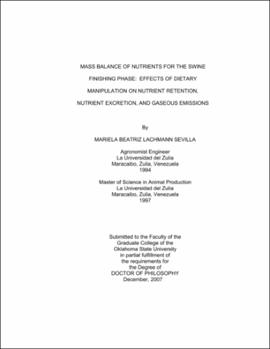| dc.contributor.advisor | Carter, S. D. | |
| dc.contributor.author | Sevilla Lachmann, Mariela | |
| dc.date.accessioned | 2013-11-26T08:22:38Z | |
| dc.date.available | 2013-11-26T08:22:38Z | |
| dc.date.issued | 2007-12 | |
| dc.identifier.uri | https://hdl.handle.net/11244/6621 | |
| dc.description.abstract | Scope and Method of Study: A total of 3 experiments were conducted to evaluate the effects of reducing dietary CP, P, and trace minerals on DM, N, P and mineral excretion, and ammonia and hydrogen sulfide emissions during the finishing period. The control was a fortified corn-soybean meal-based diet. The experimental diet was a low nutrient excretion (LNE) diet similar to the control with the exceptions that CP (2% units in Experiment 1, 4% units in Experiment 2, and 3% units in Experiment 3) and P (0.1% units in the 3 experiments) were reduced, phytase added (Experiment 3), and trace minerals sequentially reduced (Experiment 3). | |
| dc.description.abstract | Findings and Conclusions: The LNE diet with 2% units reduction in CP reduced daily N and P excretion by 20% and 24%, respectively, and tended to reduce cumulative N and P excretion in a similar proportion. However, feeding LNE with 2% units reduction in CP had little effect on daily and total mineral excretion during the finishing period. When CP was further reduced by 4% units, daily N and P excretion was reduced by 40 and 25%, respectively, and cumulative N and P excreted for the entire period by 1.36 and 0.14 kg/finished pig, respectively, during a 112-day finishing period. When CP was reduced by 3% units, P by 0.1% unit, phytase added, and trace mineral inclusion reduced, nutrient excretion and ammonia emission was markedly decreased during the finishing period. The proportion of N and P entering the finisher that exited via the pigs increased from 47 to 58% for N and 37 to 48% for P for pigs fed LNE compared with those fed the control. These results suggest that reductions in dietary CP, P and trace minerals in growing-finishing diets markedly decreased DM, N, P and mineral excretion, and ammonia emission, without affecting pig growth performance or fat-free lean gain. Therefore, dietary manipulation is an effective strategy to reduce nutrient excretion and ammonia emissions simultaneously. | |
| dc.format | application/pdf | |
| dc.language | en_US | |
| dc.rights | Copyright is held by the author who has granted the Oklahoma State University Library the non-exclusive right to share this material in its institutional repository. Contact Digital Library Services at lib-dls@okstate.edu or 405-744-9161 for the permission policy on the use, reproduction or distribution of this material. | |
| dc.title | Mass balance of nutrients for the swine finishing phase: Effects of dietary manipulation on nutrient retention, nutrient excretion, and gaseous emissions | |
| dc.contributor.committeeMember | Teeter, R.G. | |
| dc.contributor.committeeMember | Hattey, J. A. | |
| dc.contributor.committeeMember | Hamilton, D. | |
| osu.filename | Sevilla_okstate_0664D_2611.pdf | |
| osu.accesstype | Open Access | |
| dc.type.genre | Dissertation | |
| dc.type.material | Text | |
| thesis.degree.discipline | Animal Science | |
| thesis.degree.grantor | Oklahoma State University | |
